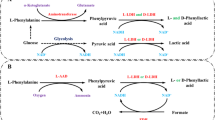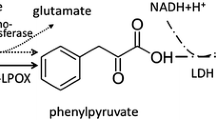Abstract
Protocatechuic acid (3,4-dihydroxybenzoic acid; PCA) serves as a building block for polymers and pharmaceuticals. In this study, the biosynthetic pathway for PCA from glucose was engineered in Corynebacterium glutamicum. The pathway to PCA-employed elements of the chorismate pathway by using chorismate-pyruvate lyase (CPL) and 4-hydroxybenzoate hydroxylase (4-HBA hydroxylase). As C. glutamicum has the potential to synthesize the aromatic amino acid intermediate chorismate and possesses 4-HBA hydroxylase, we focused on expressing Escherichia coli CPL in a phenylalanine-producing strain of C. glutamicum ATCC21420. To secrete PCA, the gene (ubiC) encoding CPL from E. coli was expressed in C. glutamicum ATCC 21420 (strain F(UbiC)). The formation of 28.8 mg/L of extracellular 4-HBA (36 h) and 213 ± 29 mg/L of extracellular PCA (80 h) was obtained by the C. glutamicum strain F(UbiC) from glucose. The strain ATCC21420 was also found to produce extracellular PCA. PCA fermentation was performed using C. glutamicum strain F(UbiC) in a bioreactor at the optimized pH of 7.5. C. glutamicum F(UbiC) produced 615 ± 2.1 mg/L of PCA from 50 g/L of glucose after 72 h. Further, fed-batch fermentation of PCA by C. glutamicum F(UbiC) was performed with feedings of glucose every 24 h. The maximum production of PCA (1140.0 ± 11.6 mg/L) was achieved when 117.0 g/L of glucose was added over 96 h of fed-batch fermentation.







Similar content being viewed by others
References
Bentley R (1990) The shikimate pathway—a metabolic tree with many branches. Crit Rev Biochem Mol Biol 25:307–384
Bradford MM (1976) A rapid and sensitive method for the quantitation of microgram quantities of protein utilizing the principle of protein-dye binding. Anal Biochem 72:248–254
Brinkrolf K, Brune I, Tauch A (2006) Transcriptional regulation of catabolic pathways for aromatic compounds in Corynebacterium glutamicum. Genet Mol Res 5:773–789
Carrott PJM, Marques LM, Carrott MMLR (2010) Characterisation of the porosity of polymer and carbon aerogels containing Fe, Ni or Cu prepared from 2,4-dihydroxybenzoic acid by n-nonane pre-adsorption and density functional theory. Microporous Mesoporous Mater 131:75–81
Carrott PJM, Marques LM, Carrott MMLR (2012) Core-shell polymer aerogels prepared by co-polymerisation of 2,4-dihydroxybenzoic acid, resorcinol and formaldehyde. Microporous Mesoporous Mater 158:170–174
Fujita T, Nguyen HD, Ito T, Zhou S, Osada L, Tateyama S, Kaneko T, Takaya N (2013) Microbial monomers custom-synthesized to build true bio-derived aromatic polymers. Appl Microbiol Biotechnol 97:8887–8894
Garner BL, Arceneaux JE, Byers BR (2004) Temperature control of a 3,4-dihydroxybenzoate (protocatechuate)-based siderophore in Bacillus anthracis. Curr Microbiol 49:89–94
George M (2001) Burgey’s manual of systematic bacteriology, 2nd edn. Springer, New York
Hasunuma T, Okazaki F, Okai N, Hara KY, Ishii J, Kondo A (2013) A review of enzymes and microbes for lignocellulosic biorefinery and the possibility of their application to consolidated bioprocessing technology. Bioresour Technol 135:513–522
Hermann T (2003) Industrial production of amino acids by Coryneform bacteria. J Biotechnol 104:155–172
Huang Y, Zhao KX, Shen XH, Jiang CY, Liu SJ (2008) Genetic and biochemical characterization of a 4-hydroxybenzoate hydroxylase from Corynebacterium glutamicum. Appl Microbiol Biotechnol 78:75–83
Kakkar S, Bais S (2014) A review on protocatechuic acid and its pharmacological potential. ISRN Pharmacol 2014: Article ID 952943, 1–9. doi:10.1155/2014/952943
Kawai Y, Noda S, Ogino C, Takeshima Y, Okai N, Tanaka T, Kondo A (2013) p-hydroxycinnamic acid production directly from cellulose using endoglucanase- and tyrosine ammonia lyase-expressing Streptomyces lividans. Microb Cell Factories 12:45
Kurusu Y, Kainuma M, Inui M, Satoh Y, Yukawa H (1990) Electroporation-transformation system for Coryneform bacteria by auxotrophic complementation. Agric Biol Chem 54:443–447
Leuchtenberger W, Huthmacher K, Drauz K (2005) Biotechnological production of amino acids and derivatives: current status and prospects. Appl Microbiol Biotechnol 69:1–8
Liebl W, Klamer R, Schleifer KH (1989) Requirement of chelating compounds for the growth of Corynebacterium glutamicum in synthetic media. Appl Microbiol Biotechnol 32:205–210
Masella R, Santangelo C, D’Archivio M, Li Volti G, Giovannini C, Galvano F (2012) Protocatechuic acid and human disease prevention: biological activities and molecular mechanisms. Curr Med Chem 19:2901–2917
Merkens H, Beckers G, Wirtz A, Burkovski A (2005) Vanillate metabolism in Corynebacterium glutamicum. Curr Microbiol 51:59–65
Nichols BP, Green JM (1992) Cloning and sequencing of Escherichia coli ubiC and purification of chorismate lyase. J Bacteriol 174:5309–5316
Noda S, Miyazaki T, Miyoshi T, Miyake M, Okai N, Tanaka T, Ogino C, Kondo A (2011) Cinnamic acid production using Streptomyces lividans expressing phenylalanine ammonia lyase. J Ind Microbiol Biotechnol 38:643–648
OECD (2009) The bioeconomy to 2030. Organization of economic co-operation and development.
Okai N, Takahashi C, Hatada K, Ogino C, Kondo A (2014) Disruption of pknG enhances production of gamma-aminobutyric acid by Corynebacterium glutamicum expressing glutamate decarboxylase. AMB Express 4:20
Okino S, Inui M, Yukawa H (2005) Production of organic acids by Corynebacterium glutamicum under oxygen deprivation. Appl Microbiol Biotechnol 68:475–480
Okino S, Noburyu R, Suda M, Jojima T, Inui M, Yukawa H (2008a) An efficient succinic acid production process in a metabolically engineered Corynebacterium glutamicum strain. Appl Microbiol Biotechnol 81:459–464
Okino S, Suda M, Fujikura K, Inui M, Yukawa H (2008b) Production of D-lactic acid by Corynebacterium glutamicum under oxygen deprivation. Appl Microbiol Biotechnol 78:449–454
Okumura S, Otsuka S, Yamanoi A, Yoshinaga F, Honda T, Kubota K, Tsuchida T (1972) Method for producing phenylalanine by fermentation. US Patent 3,660,235.
Schneider J, Wendisch VF (2010) Putrescine production by engineered Corynebacterium glutamicum. Appl Microbiol Biotechnol 88:859–868
Semaming Y, Pannengpetch P, Chattipakorn SC, Chattipakorn N (2015) Pharmacological properties of protocatechuic acid and its potential roles as complementary medicine. Evid Based Complement Alternat Med 2015: Article ID 593902, 1-11. doi:10.1155/2015/593902
Shen X, Liu S (2005) Key enzymes of the protocatechuate branch of the beta-ketoadipate pathway for aromatic degradation in Corynebacterium glutamicum. Sci China C Life Sci 48:241–249
Siebert M, Severin K, Heide L (1994) Formation of 4-hydroxybenzoate in Escherichia coli: characterization of the ubiC gene and its encoded enzyme chorismate pyruvate-lyase. Microbiology 140(Pt 4):897–904
Stadthagen G, Kordulakova J, Griffin R, Constant P, Bottova I, Barilone N, Gicquel B, Daffe M, Jackson M (2005) p-hydroxybenzoic acid synthesis in Mycobacterium tuberculosis. J Biol Chem 280:40699–40706
Sun JJ, Zhou DM, Fang HQ, Chen HY (1998) The electrochemical copolymerization of 3,4-dihydroxybenzoic acid and aniline at microdisk gold electrode and its amperometric determination for ascorbic acid. Talanta 45:851–856
Takahashi C, Shirakawa J, Tsuchidate T, Okai N, Hatada K, Nakayama H, Tateno T, Ogino C, Kondo A (2012) Robust production of gamma-amino butyric acid using recombinant Corynebacterium glutamicum expressing glutamate decarboxylase from Escherichia coli. Enzym Microb Technol 51:171–176
Tateno T, Fukuda H, Kondo A (2007) Direct production of l-lysine from raw corn starch by Corynebacterium glutamicum secreting Streptococcus bovis alpha-amylase using cspB promoter and signal sequence. Appl Microbiol Biotechnol 77:533–541
Tateno T, Okada Y, Tsuchidate T, Tanaka T, Fukuda H, Kondo A (2009) Direct production of cadaverine from soluble starch using Corynebacterium glutamicum coexpressing alpha-amylase and lysine decarboxylase. Appl Microbiol Biotechnol 82:115–121
Tsuchidate T, Tateno T, Okai N, Tanaka T, Ogino C, Kondo A (2011) Glutamate production from beta-glucan using endoglucanase-secreting Corynebacterium glutamicum. Appl Microbiol Biotechnol 90:895–901
Unthan S, Grunberger A, van Ooyen J, Gatgens J, Heinrich J, Paczia N, Wiechert W, Kohlheyer D, Noack S (2014) Beyond growth rate 0.6: what drives Corynebacterium glutamicum to higher growth rates in defined medium. Biotechnol Bioeng 111:359–371
US Department of Energy (2004) Top value added chemicals from biomass, volume I - results of screening for potential candidates from sugars and synthesis gas. T.Werpy and G. Petersen. the Pacific Northwest National Laboratory (PNNL).
Weber C, Bruckner C, Weinreb S, Lehr C, Essl C, Boles E (2012) Biosynthesis of cis, cis-muconic acid and its aromatic precursors, catechol and protocatechuic acid, from renewable feedstocks by Saccharomyces cerevisiae. Appl Environ Microbiol 78:8421–8430
Williams KM, Martin WE, Smith J, Williams BS, Garner BL (2012) Production of protocatechuic acid in Bacillus thuringiensis ATCC33679. Int J Mol Sci 13:3765–3772
Wilson MK, Abergel RJ, Raymond KN, Arceneaux JE, Byers BR (2006) Siderophores of Bacillus anthracis, Bacillus cereus, and Bacillus thuringiensis. Biochem Biophys Res Commun 348:320–325
Zhou L, Huang TW, Wang JY, Sun S, Chen G, Poplawsky A, He YW (2013a) The rice bacterial pathogen Xanthomonas oryzae pv. oryzae produces 3-hydroxybenzoic acid and 4-hydroxybenzoic acid via xanB2 for use in xanthomonadin, ubiquinone, and exopolysaccharide biosynthesis. Mol Plant Microbe Interact 26:1239–1248
Zhou L, Wang JY, Wu J, Wang J, Poplawsky A, Lin S, Zhu B, Chang C, Zhou T, Zhang LH, He YW (2013b) The diffusible factor synthase XanB2 is a bifunctional chorismatase that links the shikimate pathway to ubiquinone and xanthomonadins biosynthetic pathways. Mol Microbiol 87:80–93
Acknowledgments
This work was partially supported by Special Coordination Funds for Promoting Science and Technology, Creation of Innovation Centers for Advanced Interdisciplinary Research Areas (Innovative Bioproduction Kobe) from the Ministry of Education, Culture, Sports, Science and Technology of Japan. We appreciate help from Drs. Fumio Matsuda, Fumiyoshi Okazaki, Satoshi Wakai and Shimpei Aikawa for discussions regarding this work. We thank Ms. Michiru Miyake for technical assistance.
Conflict of interest
The authors declare that they have no competing interests.
Author information
Authors and Affiliations
Corresponding author
Ethics declarations
Compliance with ethical standards
This article does not contain any studies with human participants or animals performed by any of the authors.
Electronic supplementary material
Below is the link to the electronic supplementary material.
ESM 1
(PDF 272 kb)
Rights and permissions
About this article
Cite this article
Okai, N., Miyoshi, T., Takeshima, Y. et al. Production of protocatechuic acid by Corynebacterium glutamicum expressing chorismate-pyruvate lyase from Escherichia coli . Appl Microbiol Biotechnol 100, 135–145 (2016). https://doi.org/10.1007/s00253-015-6976-4
Received:
Revised:
Accepted:
Published:
Issue Date:
DOI: https://doi.org/10.1007/s00253-015-6976-4




